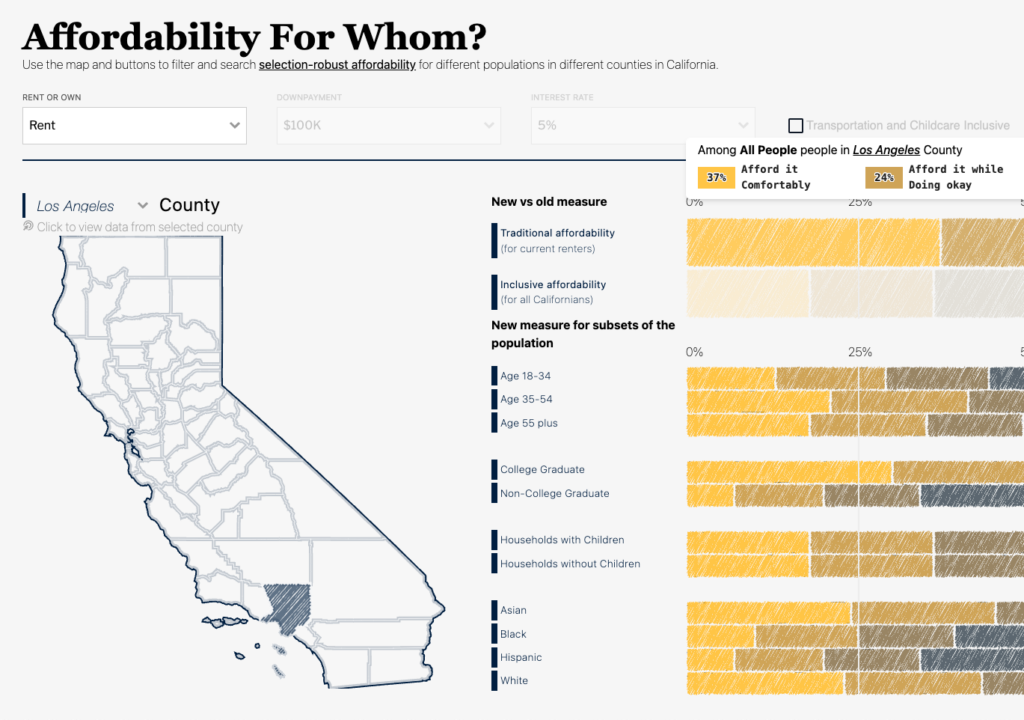Reaffirming the Federal Commitment to Fair Housing: Lessons from California in Implementing AFFH
Published On March 20, 2023
On January 19th, the U.S. Department of Housing and Urban Development (HUD) released a new proposed Affirmatively Furthering Fair Housing (AFFH) rule. The proposed rule—which reinstates and builds on the Obama administration’s 2015 AFFH rule—is intended to help address decades of housing discrimination and ensure that every neighborhood offers its residents opportunities to thrive.
Under the proposed AFFH rule, recipients of HUD funding— including local and state governments and public housing authorities—will be required to submit an Equity Plan to HUD every five years as a condition of receiving funds. The Equity Plan must analyze factors that contribute to segregation and other disparities in housing opportunities and set concrete goals to address those issues.
The proposed rule implements the provisions of 1968 Fair Housing Act (FHA) that require HUD and its grantees to go beyond prohibiting discrimination and take active steps to promote fair housing choice, foster inclusive communities, and eliminate disparities in housing. Although AFFH has been a part of federal law for over 50 years, a lack of political will at the federal level prevented meaningful implementation until 2015. The 2015 AFFH rule was a response to demands by civil rights groups that the federal government address persistent segregation through better enforcement of the FHA. It was also part of the Obama administration’s efforts to address urban racial inequities that were highlighted by the police killings of Michael Brown and Freddie Gray and the wave of Black Lives Matter protests condemning these injustices. However, the Trump administration dismantled the AFFH rule in 2018 before most grantees carried out the planning process.
Despite the break in federal action on AFFH, California has been working to pursue AFFH goals since the 2015 rule was put into place, with a particular focus on creating racially and economically integrated communities. Specifically, California has undertaken three key efforts under AFFH: establishing a statewide Opportunity Map to encourage the construction of more affordable housing in higher-resource areas, integrating fair housing goals into its Housing Element planning process, and creating a state level law to ensure AFFH remains a focus regardless of political swings at the federal level. This commentary examines California’s efforts, successes, and ongoing challenges to provide lessons for other states as they prepare to meet their AFFH goals under the new federal rule.
Incentivizing Affordable Housing in High-Opportunity Neighborhoods
Like other states, California had historically awarded most of its affordable housing subsidies to projects located in lower-income neighborhoods. Between 2003 and 2015, only five percent of large family Low-Income Housing Tax Credit (LIHTC) units placed in service were located in the state’s highest opportunity neighborhoods, even though such neighborhoods account for one-fifth of the state’s census tracts. This practice perpetuated patterns of segregation by functionally excluding low-income residents from living in high-opportunity neighborhoods. In an effort to reverse this trend, the State decided to prioritize the siting of new affordable housing in high-opportunity areas through the state’s LIHTC allocation process and other multifamily affordable housing subsidy programs.
The State engaged research partners—including the Terner Center, the California Housing Partnership Corporation, and the Othering & Belonging Institute—to create a mapping tool that scores census tracts according to the level of opportunity they offer to residents. The State’s Opportunity Map classifies areas as low-, moderate-, high-, and highest-resource based on economic, educational, health, and environmental indicators that research has shown are tied to positive outcomes. When developers apply for LIHTC or other state affordable housing programs, projects in high- or highest-resource areas receive additional points in the scoring process.
These changes have been successful in directing new housing to high-opportunity areas. Research from the USC Price Center compared the four years before and after California changed its LIHTC process in 2016 and found that the number of funded affordable housing units for families with children in higher-resource areas increased by over 60 percent, from 889 to 1,431. The share of applications for large family developments in higher-resource areas also increased from 19 percent to 29 percent, suggesting that developers are responding to these new criteria.
While these policy shifts have led to a meaningful shift in where new affordable housing is being built, there are ongoing discussions about how the goals for AFFH need to go beyond expanding choice in higher-resource neighborhoods. Some community groups have expressed frustration that the updated funding process disadvantages low-income communities, which are also in dire need of more affordable housing to relieve ongoing displacement pressures in the face of rising rents. Additionally, building affordable housing in high-opportunity areas may run counter to climate goals because those areas tend to be further from transit and job centers.
The process of developing the Opportunity Map also demonstrates the difficulty of quantifying opportunity and the challenges in accessing real-time data in the context of rapid neighborhood change. Choosing indicators is simultaneously an evidence-based and ideological exercise, and small methodological changes can alter map results. Additionally, concepts that research suggests are associated with positive outcomes but that are difficult to measure—such as social capital or qualitative measures of school quality—are not easily captured in a map. The State continues to work with stakeholders to refine the methodology while staying focused on the AFFH goal of expanding housing choice in higher-resource neighborhoods.
Requirements for Local Rezoning Efforts as Part of the State’s Housing Element Process
Changing funding criteria can do little without an adequate number of sites zoned for multifamily housing in higher-resource areas. As part of a broader set of regulatory reforms, California’s Housing Element process has been recently updated to ensure that local governments adequately zone for multifamily and affordable housing. Since 1969, California state law has required local governments to update the Housing Element of their general plan every eight years, describing how they plan to meet their state-mandated housing targets. These targets prescribe the number of housing units that local governments must plan for at each income level.
Until recently, Housing Element law was weakly enforced and had no requirements for how new housing was distributed across cities and neighborhoods. Local jurisdictions repeatedly fell far short of housing goals and have often concentrated multifamily and/or affordable sites in low-income neighborhoods. Recent legislation has strengthened the mechanisms for holding local jurisdictions accountable in the Housing Element process. Additionally, in 2017, Assembly Bill (AB) 1771 added an enhanced racial equity focus to state-mandated housing targets with an explicit mandate that the distribution plans for the housing targets affirmatively further fair housing. If local jurisdictions cannot demonstrate that they have adequate sites available to meet their housing targets, including in high-resource areas, they are required to complete rezonings within one to three years of Housing Element adoption.1 For example, San Francisco’s Housing Element, which has been approved by the State, projects that at least 49,000 units of its 82,000 unit state-mandated housing target will be achieved through rezoning. Many of the neighborhoods that would see the largest increases in density are located in high- and highest-resource neighborhoods in the western half of the city that have seen very few new homes built over the last several decades.
Codifying and Expanding AFFH Goals at the State Level
In 2018, California codified federal AFFH goals at the state level through AB 686. The state law creates a legal framework for AFFH in California and helps insulate AFFH efforts from being weakened or removed in the future. Significantly, AB 686 requires all state and local public agencies to affirmatively further fair housing, giving the goals far broader reach than the proposed federal AFFH rule, which only covers state and local public agencies that administer federal housing funds.
AB 686 also requires all local jurisdictions to complete a new AFFH analysis as part of the most recent Housing Element cycle. To help local jurisdictions comply with state AFFH obligations, the State released a detailed AFFH guidance memo, created an AFFH Data Viewer that allows local jurisdictions to view various AFFH data layers, and provided regional agencies with substantial resources to provide technical assistance to local jurisdictions.
California’s Experience Reveals the Need for a Broad Set of AFFH Strategies
California’s experience implementing and strengthening AFFH demonstrates that land use reforms must accompany the kinds of funding reforms that are usually the focus of federal AFFH efforts. However, even land use reforms may be insufficient; expensive land and fierce local opposition in high-opportunity neighborhoods layer on top of high costs for labor, construction materials, and fees. One way California is working to address these issues is through a suite of recent legislation to streamline the approval process for various types of new housing.
California’s efforts also reinforce the importance of AFFH strategies that simultaneously promote both integration and investment in low-income communities. Policies that promote community development, preserve existing lower-cost homes, and prevent displacement are all crucial ingredients to ensure that all neighborhoods offer access to opportunity.
Finally, the process in California points to the benefits of using data—even if challenging to get “right”—to guide affordable housing investments, inform changes to land use regulations, and to track and measure progress toward AFFH goals.
The new federal AFFH rule presents an opportunity for states and localities across the country to make long overdue progress toward fulfilling the FHA’s promise of fair housing for all Americans. California’s efforts demonstrate that intentional policy decisions are critical in advancing those goals.
Note that HUD has invited comments from the public on its AFFH rule through 4/10/2023. Comments can be submitted here.
Endnotes
- Under AB 1398 (2021), jurisdictions have one year to complete their required rezonings. AB 1398 allows a jurisdiction to receive a one-year extension if its rezoning accommodates at least 75 percent of units for low- and very low-income households. Additionally, SB 197 (2022) extended the timeline to complete required rezonings from one year to three years for jurisdictions whose 6th cycle housing elements were due in 2021.
Acknowledgments
Thank you to our Terner Center colleague Carolina Reid for her review and feedback on this work.
This research does not represent the institutional views of UC Berkeley or of the Terner Center’s funders. Funders do not determine research findings or recommendations in Terner Center’s research and policy reports.





